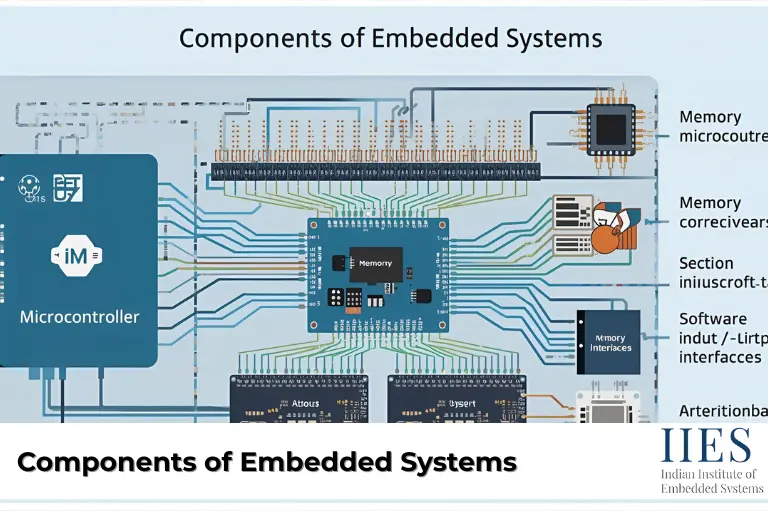
Embedded systems are everywhere—from your washing machine to modern cars, smartphones, and IoT devices. To understand how these smart systems work, you first need to know their core building blocks. This guide breaks down the main Components of Embedded Systems in simple language, making it easy for beginners and students to follow.
Embedded systems power countless devices we use daily, from smart appliances to industrial machines. They combine hardware components of embedded systems and software to perform dedicated tasks with speed and accuracy. By learning their memory in embedded systems and other parts, students can better understand how technology shapes modern life.
From simple gadgets to complex IoT solutions, embedded systems play a key role in automation and control. Each component works together to process data, manage power, and enable communication. This makes them essential for building efficient and reliable electronic systems.
Embedded systems consist of hardware, software, and RTOS components, including microcontrollers, memory, sensors, actuators, and communication interfaces.
Embedded system components are essential parts that allow a device to perform specific functions within a larger system. They include hardware components of embedded systems like processors and memory in embedded systems, and software tools like compilers and debuggers. Together, they create a complete environment where data is processed, stored, and communicated.
Embedded system components can be broadly classified into three categories:
Let’s look at each in detail
Hardware components of embedded systems form the physical backbone of any embedded system. These include processors, memory types in embedded systems, timers, sensors, and input/output devices. Without reliable hardware, the system cannot process data or interact with the environment effectively. It provides the foundation on which software and RTOS can function.
Every embedded system requires a stable power source.
The processor is the brain of the system. It can be a microcontroller (MCU) or a microprocessor (MPU).
Memory in embedded systems stores both instructions and data.
Timers help control time-based tasks like delays, alarms, and cycle counts. For example, washing machines use timers to switch between wash and spin cycles.
An interrupt controller manages signals from different devices.
Communication interfaces in embedded systems help devices talk to external hardware or networks.
Sensors allow systems to sense the environment.
Actuators in embedded systems convert electronic signals into physical actions.
Peripherals extend functionality beyond the CPU.
Software components define how the hardware behaves and ensure that tasks are executed properly. They include compilers, linkers, debuggers, and emulators that help developers write, test, and optimize code. Good software tools make it easier to manage memory types in embedded systems and improve performance. Together, they bring the hardware to life with intelligence.
Combines multiple code files into one final executable program. Without a linker, a system cannot run smoothly.
A debugger helps detect and fix errors in the code. It shows why the program did not run as expected.
An emulator mimics another system’s behavior. Developers use it to test designs without the actual hardware.
A Real-Time Operating System (RTOS) helps embedded systems online training manage multiple tasks efficiently. It ensures that critical processes are executed within strict time limits without delay. RTOS is especially important in applications like robotics, automotive, and industrial automation where timing is crucial. It adds reliability and predictability to system behavior.
Communication interfaces allow embedded systems to connect with sensors, actuators, and external devices. Technologies like UART, SPI, I2C, and Ethernet help in smooth data transfer. Wireless options such as Wi-Fi and Bluetooth make integration with IoT platforms possible. Without communication, an embedded system would remain isolated and less functional.
These technologies allow systems to share data, control devices remotely, or connect to IoT platforms.
Sensors enable embedded systems to sense and respond to real-world conditions like temperature, pressure, or motion. Power management ensures these systems run efficiently, even with limited battery capacity. Both elements are essential in modern devices, especially in IoT and portable electronics. They improve performance while reducing energy consumption.
Sensors are the eyes and ears of embedded systems.
Power management ensures longer device life and efficiency.
Memory plays a vital role in storing instructions and data needed by the processor. Embedded systems commonly use RAM for temporary storage and ROM or Flash for permanent code storage. Choosing the right type of memory balances speed,cost, and power usage. Efficient memory design improves system reliability and responsiveness.
Efficient memory selection helps balance speed, cost, and power consumption.
Knowing the components of embedded systems helps students, engineers, and businesses create better designs. It builds a strong foundation for learning advanced topics like IoT, robotics, and automation. Engineers can optimize performance and reduce costs by selecting the right parts. For businesses, this knowledge translates into reliable and energy-efficient products.
Embedded systems are the backbone of modern electronics. By combining processors, memory types in embedded systems, sensors, actuators in embedded systems, and smart software, they power everything from home appliances to connected IoT devices. Understanding these components is the first step toward designing reliable, efficient, and future-ready systems.
The main components include hardware components of embedded systems, software tools, sensors, actuators, memory units, and communication interfaces.
Hardware provides the physical structure, while software manages tasks, memory, and communication, enabling the system to function efficiently.
Common memory types include RAM (SRAM, DRAM, SDRAM) for temporary storage and ROM (EEPROM, Flash) for permanent program storage.
Sensors gather environmental data, while actuators in embedded systems convert electronic signals into physical actions.
Communication interfaces in embedded systems allow devices to connect with external hardware, networks, and IoT platforms, enabling data transfer and control.
Power management in embedded systems uses low-power circuits, sleep modes, and optimized battery usage to extend device life and efficiency.
Indian Institute of Embedded Systems – IIES